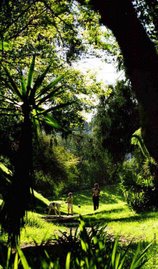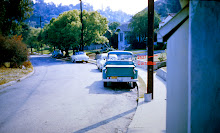
Ever wonder what those concrete blocks are on the hillside above the Arco Station at Riverside and Fletcher Drives in Silver Lake? Hope Urban, who grew up in the neighborhood, calls them “Silver Lake’s Stonehenge.”
What are those concrete blocks? Who put them there? What purpose did they serve? While many neighbors think of them as gravestones of failed Red Car Property developers, they’re actually a piece of Los Angeles History.
While the Fletcher Red Car Viaduct no longer exists, its concrete foundations stood silent vigil to the changing attitudes toward public transportation in 20th Century Los Angeles.
The Pacific Electric “Big Red Car” trolleys were a hugely popular means of transportation for Los Angeles, particularly among the neighborhoods on the Edendale and Glendale lines.
In 1904, L.C. Brand & Assoc. constructed the Fletcher Viaduct for Los Angeles & Glendale Electric Railway, then sold the Glendale Line to Pacific Electric in 1906.
The viaduct, or bridge, was huge: 453’6” long, and 40’9” high, of wood trestle construction. In 1927, a 97’ center section of the viaduct was replaced with steel, accommodating the paving of Fletcher Drive. Fletcher was also lowered; the viaduct then stood 61’ above the roadway.
The Pacific Electric Red Car created the horizontal development pattern for Los Angeles – the sprawl we have today. Everywhere a Red Car Line was planned, real estate speculators followed.
Locally, the Glendale and Edendale Lines brought settlement to the Ivanhoe Hills. Our Silver Lake neighborhood reflects the typical development pattern surrounding Red Car Lines. In the early part of the century, as soon as new Red Car lines were planned, real estate speculators bought up the land immediately adjacent to the tracks; carved it into tiny lots; sold the lots to working families to build their own homes.
Riverside Place is one such street where it’s not unusual to find 500 sq. ft. homes on 800 sq. ft. lots. Moving further out from the tracks, homes and lots get larger. The ensuing socio-economic diversity still surrounds the Red Car Property in Silver Lake today. Most neighborhoods adjacent to Red Car Lines were bulldozed for freeway construction. Thus, making our neighborhood unique.
Homes and neighborhoods were built with easy access to the Red Car stops, with public stairways and walkways instead of streets. In 1955, the Glendale Line was decommissioned and the tracks removed in favor of freeway construction. [The viaduct was dismantled in 1959, along with the viaducts at Riverside and Glendale Blvd.] Neighbors on Riverside Place voted to give up 10’ of their front yards so the City could pave the street to their homes. Today, many of those homes have no setbacks or driveways.
The Red Car Viaduct Footings are symbolic of changing attitudes toward public transportation in 20th Century Los Angeles. First, Southern Californians embraced the Red Car as an economical, efficient and popular means of public transportation. Mid-century, the Red Cars were forgotten in favor of automobiles and freeways. Late in the 20th Century, Southern Californians rediscovered the Red Car, studying a successful model of public transportation.
The Fletcher Red Car Viaduct Footings are more than just the foundation for a Pacific Electric bridge. The concrete blocks are a foundation for not only Los Angeles, but also the region. Settlers, real estate speculators and population growth followed the Red Car Lines, wherever they went.
In 2003, the Los Angeles City Council confirmed the action of the Cultural Heritage Commission, declaring the Fletcher Red Car Trestle Footings as Historic-Cultural Monument #770.
As one neighbor put it, “It’s an oddly beautiful testament to our community’s past. It’s a quirky kind of landmark that fits Silver Lake.” The Red Car Viaduct Footings bring a unique identity to our neighborhood.


